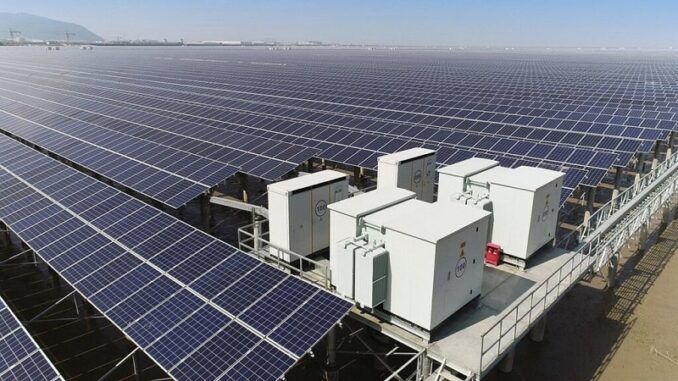
China’s photovoltaic inverter manufacturer Sungrow Power Supply on July 15, 2024 signed an agreement with Saudi Arabia’s Algihaz Holding for an energy storage project with a capacity of 7.8GWh.
PV Magazine describe this as “amounting to the world’s largest grid-side storage order.”
Sungrow Power Supply, the global leading PV inverter and energy storage system provider, secured the top spot in the 2023 global PV inverter shipment rankings according to S&P Global Commodity Insights.
The project, located in three sites in Saudi Arabia -Najran, Madaya and Khamis Mushait regions, is expected to be delivered this year. It will improve the stability and reliability of Saudi Arabia’s power grid and help realise Saudi Vision 2030.
China-based industry source Energy Trend, reports that:
“The project is large in scale, with tight delivery schedule, complex dispatching management, and high requirements for grid support and operation and maintenance. Sungrow will deploy more than 1,500 PowerTitan2.0 liquid-cooled energy storage systems for this project.
It is expected to start delivery in 2024 and achieve full capacity grid-connected operation in 2025. The project will effectively improve the stability and reliability of Saudi Arabia’s power grid and continue to promote the realization of Saudi Arabia’s Vision 2030.”
“PowerTitan2.0 adopts an integrated AC storage design with high energy density, which can help customers save 55% of land area. The equipment can be pre-installed and pre-commissioned before leaving the factory, and it can be connected to the grid when it arrives at the station. At the same time, relying on Sungrow’s intelligent manufacturing capabilities and global sales and service system, it can meet the project’s extremely fast delivery needs.”
“In addition, this project is equipped with nearly 7.8 million battery cells. In order to solve the huge challenges of operation and maintenance, Sungrow uses intelligent systems to ensure efficient and safe operation from battery cells to pack to system and then to energy storage power stations.”
** Saudi Vision 2030 is a government program launched by the Kingdom of Saudi Arabia which aims to achieve the goal of increased diversification economically, socially and culturally.
One of the overriding goals of Vision 2030 is economic diversification. Long dependent on oil exports, Saudi Arabia’s economy is now branching out. Its non-oil GDP ratio rose from 55 percent in 2016 to 59 percent in 2020. Non-oil revenues also rose from SR166 billion in 2015 to SR369 billion in 2023. Saudi Arabia aims to obtain 50 percent of its energy capacity from renewables by 2030. As part of its commitment to combating climate change, the Kingdom has encouraged the concept of a circular carbon economy, adopted by the G20, and expanded its solar, hydrogen and ammonia projects.
Sources:
- Energy Trend, July 15, 2024. https://www.energytrend.com/news/20240716-47884.html
- Pv-magazine, July 16, 2024. https://www.pv-magazine.com/2024/07/16/sungrow-secures-7-8-gwh-battery-storage-deal-from-saudi-arabia/
- Arab News, July 17, 2024. https://www.arabnews.com/node/1849981/saudi-arabia